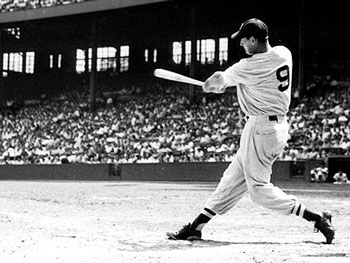August 2012 Volume 17, No. 8

The Ted Williams’ Big Dipper

Alcor and Mizar are the two stars visible to the naked eye at the bend in the handle of the Big Dipper. The next brightest star below Alcor and to the left of Mizar is third star reported seeing during his night vision aviators eye test. NOAA Image
Ted Williams, the legendary Boston Red Sox ball player, racked up a stack of records in his 21 years on the team. He remains the last player to bat over .400 in a single season.
Many of Williams’ records are common knowledge to “The Tribe”, who none the less will yet again read them here with relish. Everyone in New England knows what the tribe is, but for the non-New Englander the tribe is those stalwart Red Sox fans, the faithful really, who every spring are certain it will be a Red Sox World Series season. The tribe gathers for worship at Fenway Park, their cathedral, which opened 100 years ago on April 20, 1912, almost six years before Ted Williams was born. Unlike most players today and virtually none with the star quality performance statistics he had from the beginning, Williams played professionally for the same team for his entire career.
Here are just a few more quick stats on Williams an extraordinary player of the game. Born on August 30, 1918 in San Diego, California, his professional career began when he signed as an amateur free agent with the Boston Red Sox in 1936 at 17. Three years later he signed as a regular player with the Red Sox. Two years later in 1941 he batted .406, a record that still stands.

Ted Williams doing what he did a lot of in 24 years with the Red Sox.
Williams picked up a few nicknames as a ball player. Three were Teddy Ballgame, The Kid and the Splendid Splinter - all baseball bats were wood back then. Hitting a baseball at all when its traveling 90+ MPH requires good vision, muscle coordination and strength. A very specific place on the round surface of the bat has to hit the ball at a very specific place on it’s surface to give it the altitude and distance needed to get it out of the park. Hitting the way Williams hit calls for an extraordinary dose of all three attributes.
Just a couple more stats, it’s baseball. In 1941 Williams hit 37 home runs, 120 RBIs, scored 135 runs, he hit 521 home runs in a single season, played in the All Star Game 19 times and had a career batting average of .344. For readers who stopped in here more for the astronomy than the baseball, those are very good numbers and they are related to the astronomy.
Williams’ 21 year professional career was interrupted twice, first by World War II and again by the Korean War. He was drafted into the military in late 1942 and signed up to be a Marine Corps aviator. Part of the physical was an eye examination. Part of that eye examination was a night vision test. This was 1942 and the country was at war. In that test, pilot candidates were told to look at a part of the Big Dipper, at the bend in the handle, and tell the examiner how many stars they saw. If they saw one star they failed. If they saw two they passed.
The story goes that when Williams was asked how many stars he saw at the bend he said three. Expressing some doubt the examiner questioned him again. Williams said, “I see three stars!” The examiner didn’t see three stars, didn’t know anything about three stars in that location. Williams passed the night vision test having seen at least two stars.
What Williams saw were the two stars everyone who passed the exam saw, the double star Alcor and Mizar. They are the two stars in the bend of the handle visible to the better than average naked eye. But he also saw a third smaller, fainter and more distant star between Alcor and Mizar, which can be seen with a telescope or good binoculars.
Williams’ version of the Big Dipper got him a place as a Marine Corps pilot. His vision helped make him the legendary home run hitter he was. By some accounts the greatest hitter of all time. He flew a fighter plane, made bombing missions during the war and was discharged back to the Red Sox in 1946. He remained a threat to pitchers and a winning player until he retired in 1960. He died at 83 in 2002 in Florida.